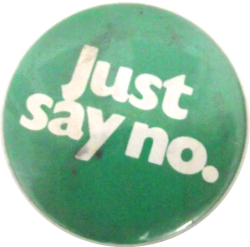The war on drugs has a victim. The drug offender.

Ronald Reagan’s presidency in the 1980s marked the start of skyrocketing rates of incarceration. This was due largely to his unprecedented expansion of the “drug war.” According to Drugpolicy.org, the number of people behind bars for nonviolent drug offenses increased from 50,000 in 1980 to over 400,000 by 1997.
The 1980s brought the media’s portrayal of people addicted to the smokeable form of cocaine called “crack” which lead to widespread public concern over drug use. And remember “Just Say No”? Soon after Reagan took office in in 1981, the First Lady began the popular anti-drug campaign “Just Say No.” That slogan was everywhere and is still engrained in the minds of anyone alive in the 1980s. This campaign set the stage for the harsh policies to follow. The 1980s also saw the formation of DARE, a drug education program. DARE was quickly adopted across the nation despite the lack of proof that the program worked.
The late 1980s saw Congress and state governments passing harsher penalties for drug crimes. The prison population increased dramatically with drug offenders. In 1985, a poll of Americans who viewed drug abuse as our country’s number one problem was between two to four percent. In September 1989, 64 perfect of Americans polled viewed drugs as our number one problem. Just Say No was working! Or at least it was increasing vigilance and putting people in prison.
Okay, maybe “working” is not the right word. Fewer people weren’t abstaining from drug use necessarily, but the public fear of drugs was at an all time high and those getting punished for drug crimes were being taken off the streets for extended periods of times and sometimes permanently. Many serving life sentences for crimes like growth of marijuana plants with intention to distribute and possession of cocaine with intent to distribute. Astonishing periods of time in many cases for non-violent crime.
The drug war has been particularly hard on African-American and Hispanic-American populations. President Obama made a historic move towards equality in the criminal justice system by signing the Fair Sentencing Act eliminating the 1 to 100 disparity in sentencing standards between crack (primarily used by poorer demographics) and powdered cocaine (the only real fun in the 80’s). This distinction between crack and traditional cocaine had been a major factor in the skyrocketing prison population of nonviolent drug offenders as well as the racial disparity of the American prison system, since crack is used mostly by African-Americans and the powdered form of the drug mostly by whites. About 85 percent of those convicted of crack cocaine possession are black.
Prior to the Fair Sentencing Act of 2010, one gram of crack cocaine was treated as the equivalent of 100 grams of powder cocaine. The Fair Sentencing Act reduced that ratio to about 1 to 18 essentially raising the possession amount of crack cocaine necessary to trigger mandatory sentences. Sounds good, right? The sentencing law will now treat similarly situated people alike. Now is the key word. What about all those people sentenced under the stricter guidelines? Does the new law apply to them?
According to the Supreme Court and circuit Courts of Appeal across the nation, the 2010 Fair Sentencing Act is was not retroactive for drug offenders sentenced before the enactment. However, drug offenders who committed their crimes before the law took affect in August 2010 but were not sentenced until later could receive the retroactive benefit of the law according to Dorsey v. United States. So, if you were sentenced on a Monday (August 3, 2010) instead of Tuesday you were out of luck!
As a result of this still looming unfairness, Obama recently commuted the sentences of thirty nonviolent offenders. Many expect more commutations to follow with approximately 30,000 applications for clemency pouring in. But Obama’s commutations and pardons alone cannot fix this problem. Hopefully, the nation will take Obama’s lead and reevaluate our drug policies. This will require a shift in drug-attitudes. When you were in school and the teacher asked, “What do you want to be when you grow up?” how many kids said, “I want to be a drug addict!”?
Socially we have made some progress since the days of “Refer Madness,” but we have a long way to go. Even marijuana charges can cause drastic damage to peoples criminal records, pocket books, careers, and families.



